Authentic Ways to Use Leaf Wrapping in Recipes
7 min read Discover the rich cultural heritage and culinary artistry of leaf wrapping in recipes, highlighting its role in flavor, tradition, and sensory delight across diverse cuisines. May 30, 2025 06:00
Authentic Ways to Use Leaf Wrapping in Recipes
Imagine the aroma of freshly steamed leaves releasing their earthy, herbal scent as you unwrap a parcel of steaming, flavorful food. Leaf wrapping is an ancient culinary technique that transcends borders and cultures, turning simple ingredients into an immersive sensory experience. In Papua New Guinean cuisine, as in many other traditions worldwide, leaves are not merely packaging; they are an integral part of the flavor, presentation, and cultural identity.
Introduction: The Art of Leaf Wrapping — A Cultural Treasure
Leaf wrapping is more than a cooking method; it's a ritual, a storytelling tradition, and a celebration of nature’s bounty. It connects us to the land, to our ancestors, and to community. In Papua New Guinea, where dense rainforests and rich biodiversity flourish, indigenous peoples have long utilized local leaves to prepare, cook, and serve their traditional dishes. This practice embodies sustainability, resourcefulness, and deeply rooted cultural values.
The Significance of Leaf Wrapping in Papua New Guinean Cuisine
Papua New Guinea’s culinary landscape is as diverse as its cultures. From the highlands to the coastal villages, leaf-wrapped dishes are common, symbolizing hospitality, respect, and ancestral knowledge.
Cultural Roots and Traditional Uses
Historically, leaves such as banana, taro, pandanus, and palm are used not only for cooking but also for ceremonial purposes. For example, during festivals or rites of passage, food wrapped in leaves is shared among community members, reinforcing bonds and honoring traditions.
Practical Benefits
Besides cultural symbolism, leaf wrapping offers practical advantages — it keeps food moist, concentrates flavors, and acts as a natural barrier against contaminants. It also enables slow cooking over fire or embers, enhancing taste and tenderness.
Types of Leaves Used in Papua New Guinean Recipes
Banana Leaves
One of the most iconic and versatile leaves, banana leaves are broad, sturdy, and impart a subtle sweetness. They are ideal for steaming, grilling, and serving.
Pandanus Leaves
Known for their aromatic qualities, pandanus leaves add a fragrant note to dishes and are often used as wrapping material or flavoring.
Taro and Taro-like Leaves
Taro leaves, rich in nutrients, are sometimes used to wrap certain dishes, especially in highland communities.
Palm and Other Local Leaves
In coastal regions, palm fronds and other local foliage are employed, each bringing unique textures and flavors.
Classic Papua New Guinean Leaf-Wrapped Dishes
Kokoda in Banana Leaves
While traditionally prepared differently, some modern renditions of the famous Kokoda fish salad are wrapped in banana leaves and lightly smoked, adding a smoky aroma and preserving freshness.
Taro and Sweet Potato Packets
In highland villages, chunks of taro and sweet potato are wrapped in banana or taro leaves, then steamed or baked over open flames. The result is a tender, flavor-infused dish perfect for communal feasts.
Seafood and Coconut Wraps
Coastal communities often prepare fish or octopus wrapped in pandanus or palm leaves, seasoned with local herbs, and cooked in underground ovens, producing a rich and aromatic dish.
Modern Innovations and Fusion
While traditional methods remain cherished, contemporary cooks are exploring new ways to incorporate leaf wrapping. From culinary tourism to gourmet restaurants, leaf-wrapped dishes are gaining popularity.
Fusion Techniques
Chefs experiment with fillings like spiced meats, exotic vegetables, and even vegetarian options, all wrapped in local leaves to retain authenticity while appealing to modern palates.
Presentation and Aesthetics
In fine dining, leaf wrapping elevates presentation, adding a rustic yet elegant touch. It emphasizes the connection to nature and highlights the freshness of ingredients.
How to Use Leaf Wrapping in Your Cooking
Selecting the Right Leaves
Choose fresh, pliable leaves free of tears or blemishes. For steaming or grilling, banana leaves are ideal due to their durability and flavor.
Preparing the Leaves
Wash thoroughly to remove dirt and sap. Blanch in hot water briefly to make them more pliable.
Wrapping Techniques
Place your fillings in the center, fold edges neatly, and secure with toothpicks or strips of leaf. For steaming, double wrap for extra protection.
Cooking Methods
- Steaming: Place wrapped parcels over boiling water, cover, and cook until flavors meld.
- Grilling: Directly over open flames or on a grill, imparting smoky notes.
- Baking: Use in an oven, wrapped securely in foil or additional leaves.
Personal Reflections and Tips
Having traveled through the lush landscapes of Papua New Guinea, I’ve witnessed firsthand the communal joy of sharing leaf-wrapped meals. The act of unwrapping reveals a fragrant, tender creation that tells a story of land, tradition, and family.
For home cooks eager to explore this technique, I recommend sourcing local or organic leaves for authenticity. Experiment with fillings that reflect your regional ingredients and cultural influences.
Conclusion: Celebrate Nature’s Bounty
Leaf wrapping is a timeless culinary art that enriches dishes with flavor, tradition, and a touch of nature’s magic. Whether you’re recreating Papua New Guinean classics or inventing your own recipes, embracing this technique invites you to connect deeply with food’s cultural roots and the environment.
So next time you prepare a meal, consider the humble leaf — a vessel of history, flavor, and community — and let it transform your cooking into a meaningful experience. Happy wrapping!**









